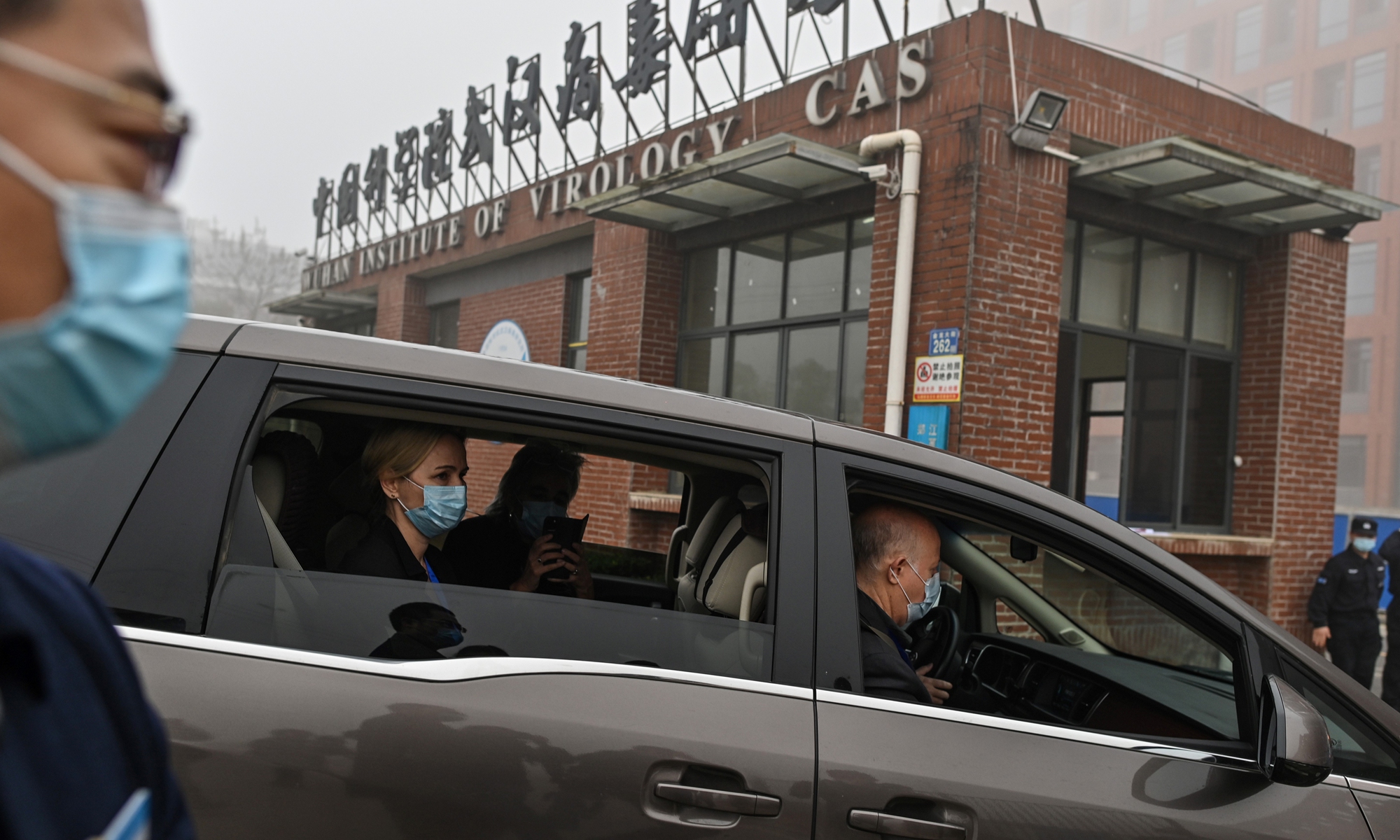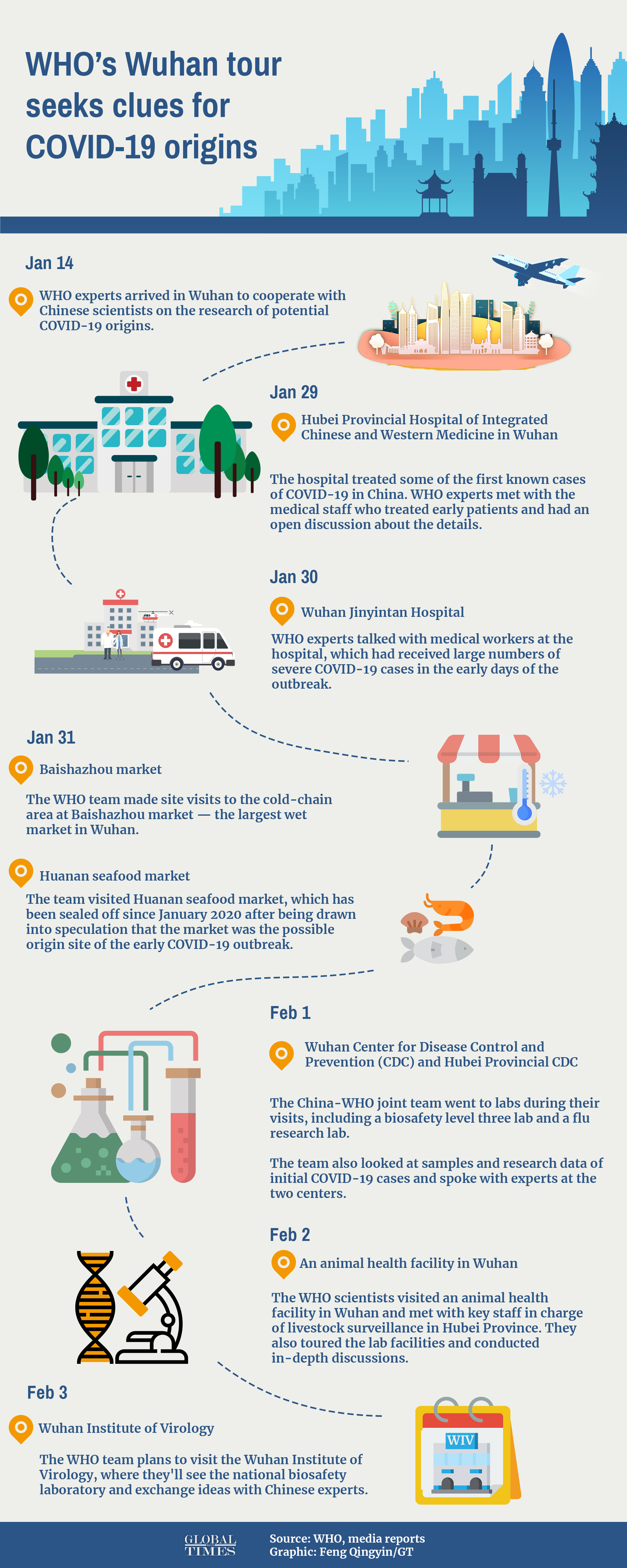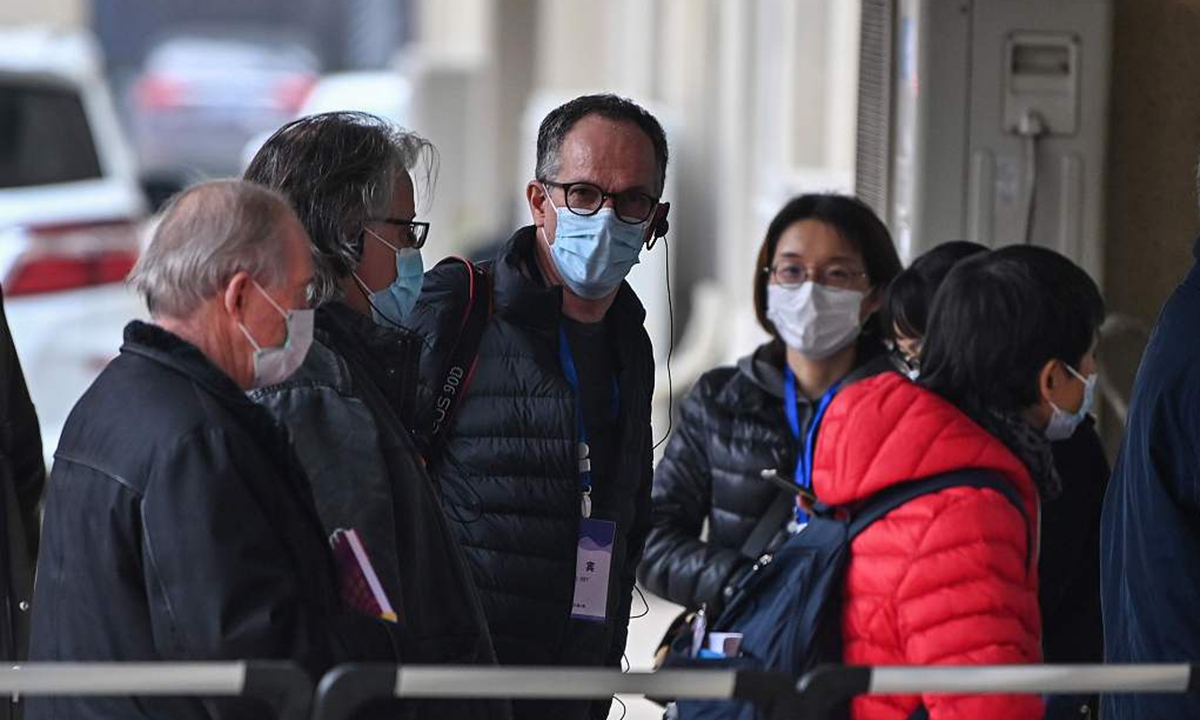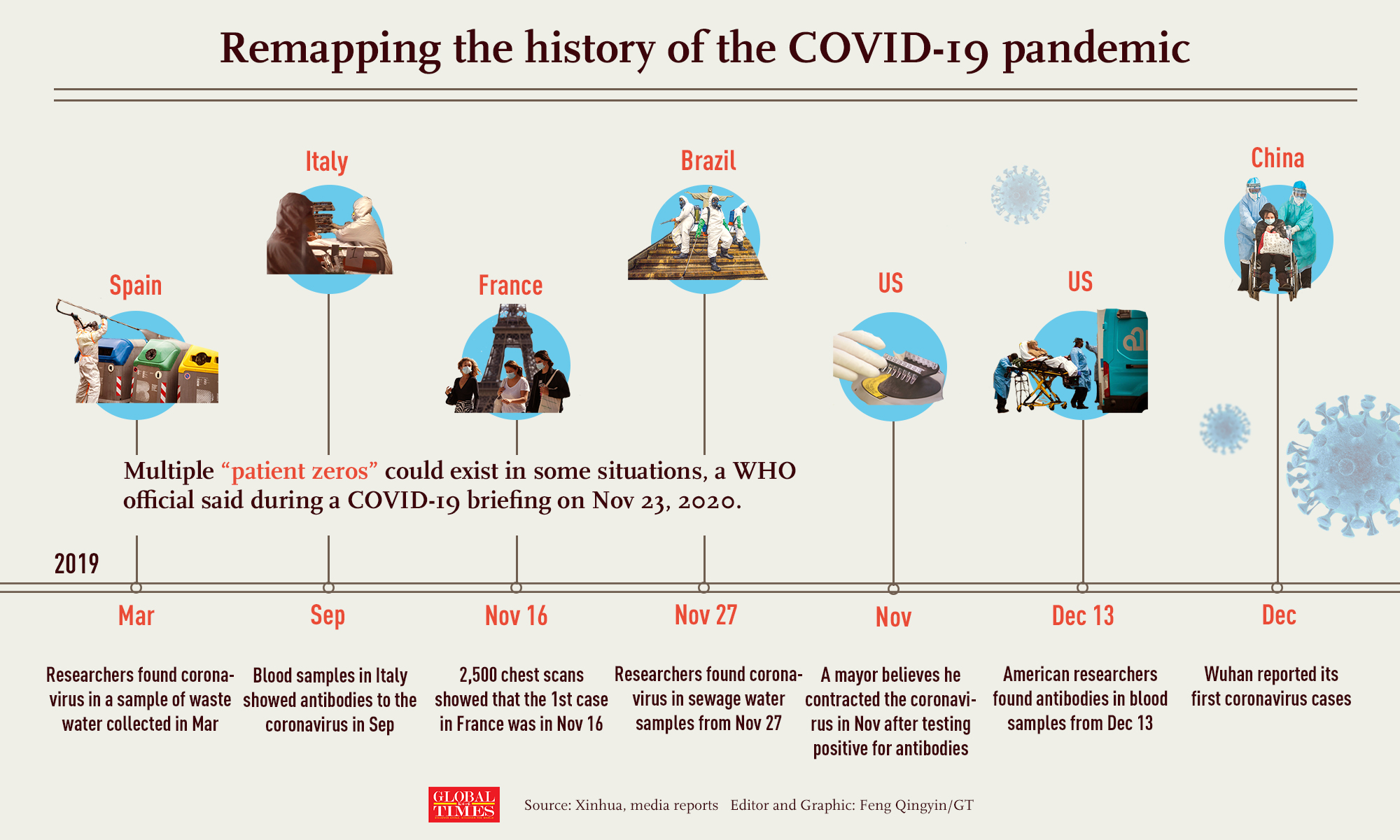
Peter Daszak (right) and other members of the World Health Organization (WHO) team investigating the origins of the COVID-19 arrive at the Wuhan Institute of Virology in Wuhan, Hubei Province on Wednesday. Photo: AFP
While the team of 13 WHO experts are halfway through their highly anticipated field visits to Wuhan, capital of Central China's Hubei Province, a number of predominant Chinese epidemiologists - including those close to the National Health Commission and Chinese CDC, jointly called for similar field studies on the origins of the novel coronavirus in other countries, as the Chinese city is considered just the first stop of such scientific work on the global scale.
They also called on the US to learn from China in inviting the team to carry out investigation as Wuhan is just the first stop of such scientific work in the world.
As the work of tracing the origins requires continuous efforts, the WHO is encouraged to discuss possible next stops for field work following the Wuhan trip, trying to resolve the puzzle of this mysterious virus with the help of more data and information from more countries and regions, Chinese experts said.
After the trip to Wuhan, the WHO should also conduct virus-tracing work in other countries, Zeng Guang, chief epidemiologist of the Chinese Center for Disease Control and Prevention (Chinese CDC), told the Global Times on Thursday.
"They should set a timeline, according to which they can collect blood samples of patients dating even back to 2019, especially those who suffered from pneumonia, to see if there's anything suspicious," Zeng said, noting that the purpose of tracing the origins is to find the patient zero or animal, but the WHO has so far not demonstrated such clear idea.
At the end of its field studies in Wuhan next week, the WHO team was anticipated to issue a report which will have some indications of what the most likely scenarios are, according to media reports, citing one of the team members. It remains unknown whether the WHO experts could produce a highly informative report on their findings which may or may not lead to some new understanding of the zoonotic sources of the novel coronavirus. But some Chinese experts closely following their work of tracing the origins considered that Wuhan, as the first stop of a global research on the origins of the coronavirus, would give them a fresh understanding and new hints for continuing their probes.
With more evidence of early cases emerging in other countries, including the US, Spain, Italy, France, Brazil and India, some even earlier than the cases reported in Wuhan, the WHO should follow those clues and continue carrying out field studies in the coming months, some experts suggested.
"Any country that reported outbreaks in 2019 should be investigated," Lu Hongzhou, co-director of the Shanghai Public Health Clinical Center at Fudan University and a member of the national COVID-19 treatment expert group, told the Global Times on Wednesday.
The WHO should conduct virus-tracing work in other countries, as it is a global pandemic, and the origins cannot be found in just a single place, Feng Duojia, president of the China Vaccine Industry Association, told the Global Times on Thursday. "Wuhan is just a stop for virus origin tracing, and those experts should not expect to find an answer here. Also, it is scientifically impossible, as there were cases found in other countries even before the outbreak in Wuhan was reported," he said.

Where have WHO experts been during their visit to Wuhan? What clues have they found about COVID-19's potential origins? Graphic: Feng Qingyin/GT
Multiple places with more clues For example, there is currently evidence of coronavirus being found in Italy before December 2019, including the latest involving a 4-year-old boy who had contracted the virus in November 2019, according to reports by Bloomberg and the South China Morning Post, which some experts believe indicates that a COVID-19 outbreak occurred in Italy earlier than in China's Wuhan, with the record of the earliest COVID-19 symptoms from a patient dating back to December 8, 2019.
Mike Ryan, head of the WHO Emergencies Program, also told a press conference in November 2020 that "identifying case zero is a very important aspect of all epidemic investigations." There could be more than one case zero because there could be more than more than one species breach, as SARS-CoV-like viruses have been identified in many different countries, he said.
The US government report released in November 2020 showed that some Americans had been infected with the novel coronavirus in mid-December 2019, prior to the first US cases identified in January 2020.
Spanish virologists have also found traces of the novel coronavirus in a sample of Barcelona waste water collected in March 2019, Reuters reported in June 2020, citing the University of Barcelona. And they also found the virus in Barcelona on January 15, 2020, or 41 days before the first case was officially reported in the country.
Besides Spain, Italy and the US, France and Brazil also found the traces of novel coronavirus earlier than the first case was officially reported in Wuhan.
"The WHO's investigation of virus sources probably won't come to anything if international experts did not go to other countries, because Wuhan is definitely not where the virus originated from," Lu said.
He explained that if Wuhan is the place where the novel coronavirus originated from, then the virus strain found in Wuhan should be very consistent, with no differentiation or mutation. But according to research conducted by Chinese experts in May 2020, genomic sequences showed there were two lineages derived from a common ancestor that evolved independently in the early stage of the Wuhan outbreak.
The study, "Viral and host factors related to the clinical outcome of COVID-19," was published in Nature. Lu was one of the authors.
As for where the virus came from, Lu said that Wuhan is an international city with frequent people exchanges, and the virus could have come from any country.
We've seen many different virus strains, which may have originated in different places. This also makes conducting the tracing work in multiple places around the world more important, Yang Zhanqiu, deputy director of the pathogen biology department at Wuhan University, told the Global Times on Wednesday.
The US has the most diverse virus strains, which make it the most suitable place for conducting study of origins, Yang said.
Calling for more WHO-led studies on the question of the origins is the right thing to do, which also needs a full discussion among the member countries while China has already launched a good start, a predominant expert close to the Chinese CDC, told the Global Times on Thursday on condition of anonymity.

Peter Ben Embarek (C) and other members of the World Health Organization (WHO) team visit a local community in Wuhan, Central China's Hubei province on February 4, 2021. Photo: VCG
Where to go next During the WHO team's visit to Wuhan, Vladimir Dedkov, an expert from Russia and also a team member, disclosed that COVID-19 could have broken out in the seafood market in the city, but there is no evidence that the virus originated there, according to a report by Sputnik on Thursday.
So now the question is, after the field studies in Wuhan, where to go next? The options are on the table, according to Chinese experts.
"Given more cases were found in other countries much earlier than in China, a key question that the WHO team needs to ask and get an answer after the Wuhan trip will be: How was the virus introduced into China, as it's unlikely a domestically grown virus but one brought in by travelers or via other means," Wang Guangfa, a respiratory expert at Peking University First Hospital, who went to Wuhan in the early stages of the outbreak, told the Global Times on Thursday.
"The WHO experts need to follow those clues about the early cases to continue field studies in countries like Spain, Brazil, Italy and the US. And it's a scientific question that does not aim to target any country, or a blame game for political purposes," he noted.
The WHO should also set criteria for selecting countries where they can conduct the field studies on the origins, Chinese experts said. Only China has demonstrated a scientific and fair attitude to invite them in. But the US should also be a key country in virus-tracing work. Its all-over-the-world biology laboratories should all be subject to virus-tracing work, Zeng stressed.
"The key origin-tracing work must be in the US," Zeng emphasized, saying that the US should learn from China to set an example for global origin-tracing efforts.
The US should invite the WHO to carry out an investigation there, Zeng said.

A recent US CDC report found COVID-19 antibodies in blood samples as early as Dec 13, 2019. With more & more evidence surfacing about the coronavirus' origins in places outside China before Wuhan detected it, the world is remapping the history of the COVID-19 pandemic. Infographic:GT







